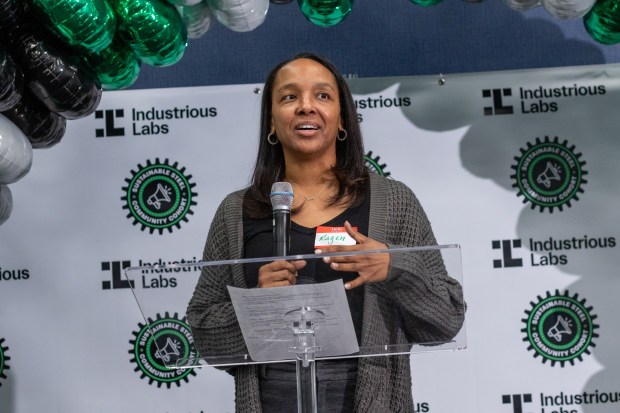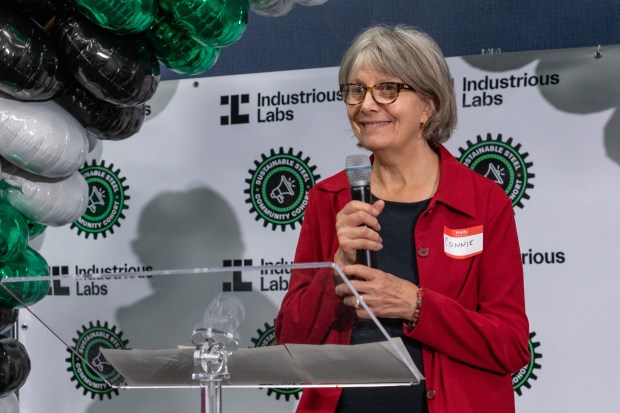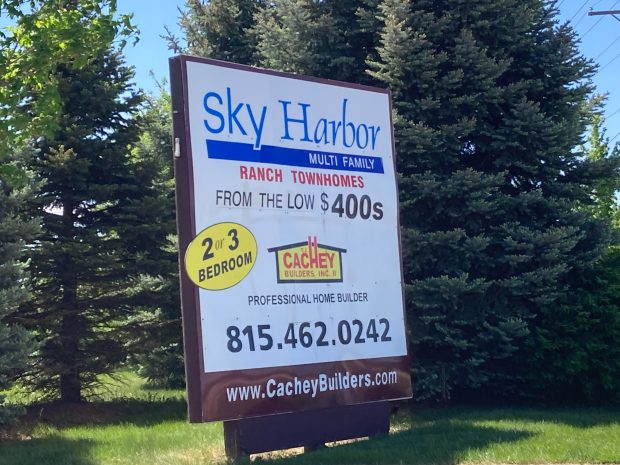Beverly Lewis has known about the positive and negative effects of the steel mills, but she thinks it’s important to continue learning.
That’s one of the reasons why she joined Northwest Indiana’s Sustainable Steel Cohort from Industrious Labs.
“I grew up in this area,” Lewis said. “There were things that I thought were normal until I went to other places to live, and my breathing improved and I felt better. I realized then that there might be a connection.”
Beverly Lewis speaks at Northwest Indiana’s Sustainable Steel Cohort graduation Oct. 5. Lewis, a cohort member, said it’s important for residents to be educated about steelmaking practices. (Photo courtesy of Michael Kaplan for Industrious Labs)
Lewis was one of 16 cohort members who graduated from the program this month. Participants were all Northwest Indiana residents and varied in backgrounds.
Hilary Lewis, steel director for Industrious Labs, said the cohort was created in response to “crossroads in the steel industry.” She believes the industry has important decisions to make, especially in Northwest Indiana.
Communities have an increased interest in green steel production, Hilary Lewis said, specifically with direct reduction furnaces. The furnaces use natural gas and could reduce carbon dioxide emissions by half.

Rep. Ragen Hatcher, D-Gary, speaks at Northwest Indiana’s Sustainable Steel Cohort graduation Oct. 5. Hatcher said the cohort has helped her understand more about what’s impacting constituents. (Photo courtesy of Michael Kaplan for Industrious Labs)
Most steel plants use blast furnaces, which use a coal product for heating and the chemical reaction. The furnace releases large amounts of carbon dioxide and toxic chemicals into the environment.
“The coal-based facilities are in Northwest Indiana,” Hilary Lewis said. “About every 20 years, these furnaces have to go through very expensive updates, which could be about $300 million or $400 million.”
Nippon Steel, a Japanese company, is offering to spend $300 million to reline the Gary Works’ blast furnace if a deal with U.S. Steel is approved. The investment would allow for higher steel production and increase the furnace’s life by up to 20 years.

Local environmental activists oppose the investment, saying the blast furnace will continue to rely on fossil fuels.
Each cohort member came from a different background, Hilary Lewis said, and she believed it was evident that they all wanted similar outcomes.
“A big theme that they agreed on was that Northwest Indiana shouldn’t be a sacrifice zone,” Hilary Lewis said. “There are clean alternatives available today that can continue the economic and job benefits while also protecting community health and the climate.”
This was the first cohort in Northwest Indiana, but Hilary Lewis believes more will happen in the future. She also thinks it will expand to other states, including Michigan and Pennsylvania.
Hilary Lewis believes it’s important for corporations to see community members care about sustainability and green steelmaking practices.
“Companies don’t operate in (isolation),” she said. “They operate in communities, so it’s important for them to hear directly from the people who live next door about what they want to see in the future.”
U.S. Steel has two sustainable steels that are produced at its Big River Steel facility in Arkansas. The steel company is the first to announce a net-zero greenhouse gas emissions goal by 2050 and is the first North American steel company to join ResponsibleSteel, a global nonprofit working to make steel more sustainable, according to U.S. Steel.
“Our goals are ambitious and long-term, and we will work to pursue them in a way that benefits our people and the places where we live and work,” the company said in a statement.
Cohort member Beverly Lewis said it’s important for residents to be educated about steelmaking practices, especially because it’s so prominent in the region.
Beverly Lewis has been interested in sustainability, and she went to a couple meetings when Fulcrum Bioenergy planned to build a trash-to-fuels facility in Gary. Fulcrum planned to invest $600 million into Gary and divert 700,000 tons of waste from local landfills annually.
The California-based company and its subsidiaries filed for Chapter 11 bankruptcy in September. Fulcrum announced the Gary facility in 2018, and it is still unbuilt.
“It’s very difficult to follow government regulations or corporate messaging if you don’t have decent knowledge of what is going on,” Beverly Lewis said.
She liked that cohort members had different backgrounds and said she liked that other people in Northwest Indiana are interested in sustainability and green steelmaking. Cohort members pledged to continue working together, she added.
“It’s very exciting,” Beverly Lewis said. “A lot of us didn’t know each other, so it was exciting to meet other people with a like-minded perspective or who are struggling with the same issues.”
Connie Wachala, from Highland, is another community member who went through the green steel cohort. Wachala has been advocating for sustainability since 2019, and she’s attended environmental conferences throughout the state.
Because of the cohort, Wachala said she’s more confident talking to elected officials or industry representatives about changes she wants to see.
Wachala believes the steel industry has positives and negatives, especially in Northwest Indiana.
“(The steel industry) keeps good jobs here, but lowering emissions is essential for bettering public health,” she added. “Mitigating some of that damage is important to ensuring that future generations can enjoy life in a hospitable climate.”
State Rep. Ragen Hatcher, D-Gary, was another cohort member. Hatcher enjoyed the program, she said, and it’s helped her understand more about what’s impacting constituents.
Hatcher also plans to bring what she learned to the statehouse.
“It was really interesting,” Hatcher said. “There was a lot of good information not just about the administrative side of the steel mill, but also how it functions, the different sections and the types of pollution that are emitted.”
Because Hatcher and her family are from Gary, she’s always seen the effects of the steel mills, especially how the loss of revenue impacted the city.
At the statehouse, Hatcher plans to educate other legislators on how steel mills can be more environmentally friendly, especially for cleaner air and water in Northwest Indiana.
She also wants other legislators to understand how steelmaking affects community members’ health, particularly with lung and heart problems.
“I want (the steel mills) to take a more active role in making sure that the communities they work in are healthy,” Hatcher said. “There needs to be a change in the way they support the community in which they manufacture steel.”





